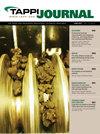具有改进强度和阻隔性能的稻草基可持续食品包装材料:开发和表征
IF 0.6
4区 农林科学
Q4 MATERIALS SCIENCE, PAPER & WOOD
引用次数: 0
摘要
以稻秆纳米纤维素为原料,研制出高阻隔性、高强度的可持续食品包装纸。采用有机溶剂法制浆和DED (D:二氧化氯漂白)对稻秆进行了制浆漂白;E:氢氧化钠萃取)漂白顺序。漂白后的稻草浆用实验室谷式搅拌器精制至90°SR。用40°SR和90°SR的纸浆制备实验室手纸。采用烷基烯二聚体(AKD)蜡对高精炼纸浆(90°SR)制成的纤维素纳米原纤维(CNFs)手纸进行表面上浆,以提高纸张的阻隔性能,用于选择性食品包装。测试纸张样品的力学、光学、表面和阻隔性能,包括拉伸指数、破裂指数、撕裂指数、弯曲刚度、伸长率、孔隙率、表观密度、不透明度、Cobb值、水蒸气透过率(WVTR)、耐油性和润滑脂性以及接触角。利用场发射扫描电镜(FE-SEM)对90°SR的精炼纸浆进行了分析,观察到发育的纤维的形态在至少一个维度上发生了纳米尺度(<100 nm)的变化。用DLS分析仪对精制纸浆的粒度分布也证实纤维素纤维接近纳米级。结果表明,采用机械浆精制工艺制备纳米纤维具有较高的经济性。CNFs样品手抄显示出良好的强度和阻隔性能。当使用低成本、无毒、可生物降解的AKD蜡进行表面上浆时,阻隔性能进一步提高。本文章由计算机程序翻译,如有差异,请以英文原文为准。
Rice straw-based sustainable food packaging material with improved strength and barrier properties: Development and characterization
Sustainable food packaging paper with high barrier and strength properties was developed with rice straw nanocellulose materials. Pulping and bleaching of rice straw were performed using an organosolv pulping and DED (D: chlorine dioxide bleaching; E: sodium hydroxide extraction) bleaching sequence. Bleached rice straw pulp was refined to 90°SR using a laboratory Valley beater. The laboratory handsheets were prepared using pulp slurry at 40°SR and 90°SR. The handsheets of cellulose nanofibrils (CNFs) made of highly refined pulp (90°SR) were surface sized using alkyl ketene dimer (AKD) wax to increase the barrier properties of paper for selective food packaging applications. The paper samples were tested for mechanical, optical, surface, and barrier properties, including tensile index, burst index, tearing index, bending stiffness, elongation, porosity, apparent density, opacity, Cobb value, water vapor transmission rate (WVTR), oil and grease resistance, and contact angle. The refined pulp (90°SR) was analyzed using field-emission scanning electron microscopy (FE-SEM), and it was observed that the morphology of the developed fibers changes to the nanoscale (<100 nm) for at least one dimension. The particle size distribution of the refined pulp using DLS analyzer also confirmed the cellulose fibers to near nanoscale. It was concluded that nanofibers were formed by a high degree of the mechanical pulp refining process and found to be much more economical than alternative processes in this direction. The sample handsheets of CNFs showed good strength and barrier properties. The barrier properties further increased when surface sizing was done using low-cost, nontoxic, and biodegradable AKD wax.
求助全文
通过发布文献求助,成功后即可免费获取论文全文。
去求助
来源期刊

Tappi Journal
工程技术-材料科学:纸与木材
CiteScore
1.30
自引率
16.70%
发文量
59
审稿时长
6-12 weeks
期刊介绍:
An internationally recognized technical publication for over 60 years, TAPPI Journal (TJ) publishes the latest and most relevant research on the forest products and related industries. A stringent peer-review process and distinguished editorial board of academic and industry experts set TAPPI Journal apart as a reliable source for impactful basic and applied research and technical reviews.
Available at no charge to TAPPI members, each issue of TAPPI Journal features research in pulp, paper, packaging, tissue, nonwovens, converting, bioenergy, nanotechnology or other innovative cellulosic-based products and technologies. Publishing in TAPPI Journal delivers your research to a global audience of colleagues, peers and employers.
 求助内容:
求助内容: 应助结果提醒方式:
应助结果提醒方式:


